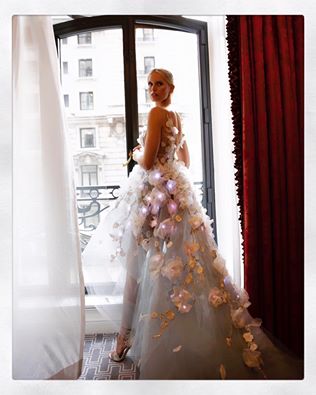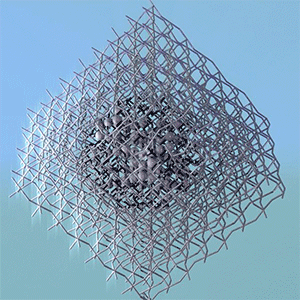I don’t usually have an opportunity to write about red carpet events but the recent Met Gala, also known as the Costume Institute Gala and the Met Ball, which took place on the evening of May 2, 2016 in New York, featured a ‘cognitive’ dress. Here’s more from a May 2, 2016 article by Emma Spedding for The Telegraph (UK),
“Tech white tie” was the dress code for last night’s Met Gala, inspired by the theme of this year’s Met fashion exhibition, ‘Manus x Machina: Fashion in the Age of Technology’. While many of the a-list attendees interpreted this to mean ‘silver sequins’, several rose to the challenge with beautiful, future-gazing gowns which give a glimpse of how our clothes might behave in the future.
Supermodel Karolina Kurkova wore a ‘cognitive’ Marchesa gown that was created in collaboration with technology company IBM. The two companies came together following a survey conducted by IBM which found that Marchesa was one of the favourite designers of its employees. The dress is created using a conductive fabric chosen from 40,000 options and embedded with 150 LED lights which change colour in reaction to the sentiments of Kurkova’s Twitter followers.
A May 2, 2016 article by Rose Pastore for Fast Company provides a little more technical detail and some insight into why Marchesa partnered with IBM,
At the Met Gala in Manhattan tonight [May 2, 2016], one model will be wearing a “cognitive dress”: A gown, designed by fashion house Marchesa, that will shift in color based on input from IBM’s Watson supercomputer. The dress features gauzy white roses, each embedded with an LED that will display different colors depending on the general sentiment of tweets about the Met Gala. The algorithm powering the dress relies on Watson Color Theory, which links emotions to colors, and on the Watson Tone Analyzer, a service that can detect emotion in text.
In addition to the color-changing cognitive dress, Marchesa designers are using Watson to get new color palette ideas. The designers choose from a list of emotions and concepts—things like romance, excitement, and power—and Watson recommends a palette of colors it associates with those sentiments.
An April 29, 2016 posting by Ann Rubin for IBM’s Think blog discusses the history of technology/art partnerships and provides more technical detail (yes!) about this one,
Throughout history, we’ve seen traces of technology enabling humans to create – from Da Vinci’s use of the camera obscura to Caravaggio’s work with mirrors and lenses. Today, cognitive systems like Watson are giving artists, designers and creative minds the tools to make sense of the world in ground-breaking ways, opening up new avenues for humans to approach creative thinking.
…
The dress’ cognitive creation relies on a mix of Watson APIs, cognitive tools from IBM Research, solutions from Watson developer partner Inno360 and the creative vision from the Marchesa design team. In advance of it making its exciting debut on the red carpet, we’d like to take you on the journey of how man and machine collaborated to create this special dress.
Rooted in the belief that color and images can indicate moods and send messages, Marchesa first selected five key human emotions – joy, passion, excitement, encouragement and curiosity – that they wanted the dress to convey. IBM Research then fed this data into the cognitive color design tool, a groundbreaking project out of IBM Research-Yorktown that understands the psychological effects of colors, the interrelationships between emotions, and image aesthetics.
This process also involved feeding Watson hundreds of images associated with Marchesa dresses in order to understand and learn the brand’s color palette. Ultimately, Watson was able to suggest color palettes that were in line with Marchesa’s brand and the identified emotions, which will come to life on the dress during the Met Gala.
Once the colors were finalized, Marchesa turned to IBM partner Inno360 to source a fabric for their creation. Using Inno360’s R&D platform – powered by a combination of seven Watson services – the team searched more than 40,000 sources for fabric information, narrowing down to 150 sources of the most useful options to consider for the dress.
From this selection, Inno360 worked in partnership with IBM Research-Almaden to identify printed and woven textiles that would respond well to the LED technology needed to execute the final part of the collaboration. Inno360 was then able to deliver 35 unique fabric recommendations based on a variety of criteria important to Marchesa, like weight, luminosity, and flexibility. From there, Marchesa weighed the benefits of different material compositions, weights and qualities to select the final fabric that suited the criteria for their dress and remained true to their brand.
Here’s what the dress looks like,
Watson is an artificial intelligence program,which I have written about a few times but I think this Feb. 28, 2011 posting (scroll down about 50% of the way), which mentions Watson, product placement, Jeopardy (tv quiz show), and medical diagnoses seems the most à propos given IBM’s latest product placement at the Met Gala.
Not the only ‘tech’ dress
There was at least one other ‘tech’ dress at the 2016 Met Gala, this one designed by Zac Posen and worn by Claire Danes. It did not receive a stellar review in a May 3, 2016 posting by Elaine Lui on Laineygossip.com,
People are losing their goddamn minds over this dress, by Zac Posen. Because it lights up.
…
It’s bullsh-t.
This is a BULLSH-T DRESS.
It’s Cinderella with a lamp shoved underneath her skirt.
…
Here’s a video of Danes and her dress at the Met Gala,
A Sept. 10, 2015 news item in People magazine indicates that Posen’s a different version of a ‘tech’ dress was a collaboration with Google (Note: Links have been removed),
Designer Zac Posen lit up his 2015 New York Fashion Week kickoff show on Tuesday by debuting a gorgeous and tech-savvy coded LED dress that blinked in different, dazzling pre-programmed patterns down the runway.
…
In coordination with Google’s non-profit organization, Made with Code, which inspires girls to pursue careers in tech coding, Posen teamed up with 30 girls (all between the ages of 13 and 18), who attended the show, to introduce the flashy dress — which was designed by Posen and coded by the young women.
“This is the future of the industry: mixing craft, fashion and technology,” the 34-year-old designer told PEOPLE. “There’s a discrepancy in the coding field, hardly any women are at the forefront, and that’s a real shame. If we can entice young women through the allure of fashion, to get them learning this language, why not?”
..
Through a micro controller, the gown displays coded patterns in 500 LED lights that are set to match the blues and yellows of Posen’s new collection. The circuit was designed and physically built into Posen’s dress fabric by 22-year-old up-and-coming fashion designer and computer science enthusiast, Maddy Maxey, who tells PEOPLE she was nervous watching Rocha [model Coco Rocha] make her way down the catwalk.
“It’s exactly as if she was carrying a microwave down the runway,” Maxey said. “It’s an entire circuit on a textile, so if one connection had come lose, the dress wouldn’t have worked. But, it did! And it was so deeply rewarding.”
Other ‘tech’ dresses
Back in 2009 I attended that year’s International Symposium on Electronic Arts and heard Clive van Heerden of Royal Philips Electronics talk about a number of innovative concepts including a ‘mood’ dress that would reveal the wearer’s emotions to whomever should glance their way. It was not a popular concept especially not in Japan where it was first tested.
The symposium also featured Maurits Waldemeyer who worked with fashion designer Chalayan Hussein and LED dresses and dresses that changed shape as the models went down the runway.
In 2010 there was a flurry of media interest in mood changing ‘smart’ clothes designed by researchers at Concordia University (Barbara Layne, Canada) and Goldsmiths College (Janis Jefferies, UK). Here’s more from a June 4, 2010 BBC news online item,
The clothes are connected to a database that analyses the data to work out a person’s emotional state.
Media, including songs, words and images, are then piped to the display and speakers in the clothes to calm a wearer or offer support.
Created as part of an artistic project called Wearable Absence the clothes are made from textiles woven with different sorts of wireless sensors. These can track a wide variety of tell-tale biological markers including temperature, heart rate, breathing and galvanic skin response.
Final comments
I don’t have anything grand to say. It is interesting to see the progression of ‘tech’ dresses from avant garde designers and academics to haute couture.

